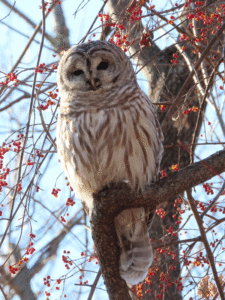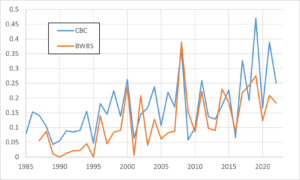(Story and photos by Pam Hunt)
Known for its distinctive “who cooks for you” call, the Barred Owl (Strix varia) is by far the most familiar owl in New Hampshire. It can be found anywhere there’s a large enough patch of forest, and increasingly seems to be adapting to suburban landscapes. The nest is either in a cavity (they readily take to nest boxes) or an old hawk, crow, or squirrel nest, usually relatively high off the ground. By April a nesting pair will likely have laid 2-5 eggs and the female begun her month-long incubation. During this time, and for a couple of weeks after the chicks hatch, she does minimal hunting and is instead provisioned by her mate. The young make their first forays out of the nest after four or five weeks but remain flightless until they are around ten weeks old, during which time they stay near the nest and navigate their forest home by climbing among branches. By September they have stopped being fed by their parents and are forced to disperse in search of territories of their own.

Put all this together and you have yet another classic case of how predators and prey are locked in a repeated cycle of ups and downs. In good rodent years the owls will produce higher numbers of young, which in turn will need to disperse to find new homes – and be more visible to human observers. Figure 1 shows this variation in numbers based on data collected in New Hampshire during the winter, when these dispersing owls are still exploring the wider world. The Christmas Bird Count occurs in late December and the Backyard Winter Bird Survey in mid-February, but both show a strong similarity in their ups and downs over the last 35 years. We can conclude that the summers preceding the peaks were those with lots of mice and squirrels in our forests.

There’s another factor that can contribute to the number of owls we see in the winter, and that is weather. When snow blankets the ground, small rodents (mice and voles in particular) can tunnel below it and be harder for owls to detect. The deeper the snow, the more difficult the hunting is, and the owls will shift toward areas with less snow (e.g., road edges) or more prey (e.g., bird feeders). Owls along roads are at increasing risk of collisions, while those at feeders can add the occasional bird to their diet of the mice and squirrels attracted to spilled seed. An icy crust on top of snow can also make hunting more difficult since it’s not as easy for the owls to dive into the snow in search of prey they can hear beneath it.
And yes, owls can locate their prey entirely by sound (they have good low-light vision as well). On the sides of their heads are two ear openings (not to be confused with the ear tufts of some owls, which have nothing to do with hearing), and the unusual thing about owls is that one is higher – and often farther forward – than the other. As a result, a sound will reach one ear a fraction of a second before the other, allowing the owl to fine-tune its trajectory as it comes in for the kill. Aiding this process are an owl’s round facial disks, which function like a parabolic reflector to funnel sounds to their ears. Aided by nearly silent flight, this hearing makes the Barred Owl and its relatives the justly-feared nocturnal predators that they are – at least if you’re a small mammal.
State of the Birds at a Glance:
- Habitat: Forests
- Migration: Non-migratory
- Population trend: Increasing
- Threats: Habitat loss, predation (Great Horned Owl, raccoons), collisions
- Conservation actions: Provide nest boxes
NH Audubon’s “Backyard Winter Bird Survey” will occur on February 11-12, 2023. Find details here, plus how to participate.
